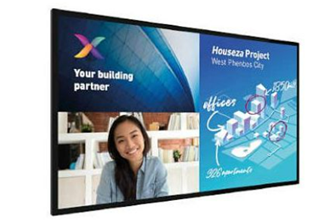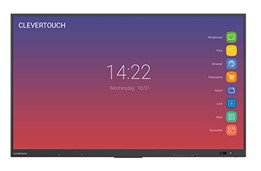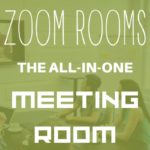
There are a number of factors to consider when choosing the right screen for video conferencing. The size of your room, the frequency of use of the system, the quality of the lighting, the intended use and your budget all play an important role in the choice of screen. We will see below that there are many parameters to consider: resolution, size and technology of the screen, but also the viewing angle, refresh rate or a touch-sensitive surface.
So how do you choose the perfect screen for your video conferences? Follow the guide!
Screen resolution
As videoconferencing becomes more popular, more stringent requirements are expected for its quality. This trend has led to many improvements such as new content sharing opportunities, more sophisticated data protection technologies and, of course, increased resolution of video streams.
The resolution is the number of pixels arranged by width and height in an image or on a screen. The more pixels there are, the better the quality of the image. The most commonly used resolutions usually have proper names such as Full HD or Ultra HD (4K).
As of 2019, Full HD (1080p) has become the most popular video conferencing format; however, 4K conferencing is gaining momentum. 4K images are approximately twice as wide and tall as Full HD images and offer an image quality that is difficult to match.
Determine the size of the screen in relation to the viewing distance
The general rule is simple: the bigger the room, the bigger the screen.
The distance from the farthest participant is a key factor in determining the type of display. There are different methods for determining the viewing distance and therefore the appropriate screen size.
For instance, the audio-visual industry trade association, AVIXA, offers the specification “ANSI/INFOCOMM V202.01:2016, Display Image Size for 2D Content in Audiovisual System”. This standard provides an evaluation tool to determine the appropriate display image size for the user’s needs. It uses several calculations that take into account content, viewer positions from multiple locations, image and font size, ambient light, off-axis viewing, the range of vision of the human eye at different angles, etc. This standard applies not only to meeting or video conferencing spaces, but also to more complex applications such as auditoriums, training sites and security operations centres (SOCs).
The AVIXA standard is very precise, but the detailed calculations below will also help you determine the size of your screen and its positioning in the room:
Distance calculation – Video content
Video is the most forgiving type of content in terms of screen size and distance. Smaller screen sizes or longer distances are acceptable. The multiplier we use for video is 8 times the picture height of the screen. For example, if you are using a 55″ screen (27″ screen height height), the maximum distance to the seats would be 216″ (8 X 27 = 216), or 18′ (about 5.5 metres).
Distance calculation – Textual content
In a mixed content environment, such as a conference room, the text content calculation should be used.
The screen multiplier calculation discussed for video can also be used here, but instead of a multiplier of 8, it should be multiplied by 6 for applications where PowerPoint presentations (large fonts) are commonly shared.
For presentations that consist mainly of data-rich content such as CAD drawings, Word or Excel documents, web pages or screen shares, a multiplier of 4 should be used.
In boardrooms and conference rooms using video conferencing (Zoom, Microsoft Teams, WebEx, etc.), a multiplier of 4 is recommended as multiple windows will be displayed.
To simplify, the screen size for a typical videoconference room can be calculated as follows:

Determining the viewpoint
Viewing angles are an important consideration, particularly in large rooms or where multiple screens are required to ensure correct display. For ideal viewing, participants should be 45 degrees to either side of the centre of the screen and the top of the screen should be 30 degrees above eye level.
Touch screens
If you are looking for creativity and idea development, you may want to consider a touch screen.
A touch screen is still just a screen. In other words, if it is not connected to something, a touch screen is pretty much useless. This “something” can be :
- A hardware component directly integrated into the display.
- An external computer (connected via HDMI for audio/video and via USB for touch capability, or other types of external devices).
A touch screen that incorporates an operating system is called an interactive touch screen.
Some examples of touch screens perfect for collaborative video conferencing:

< Touch screen Philips 86BDL8051C00

Interactive screen Clevertouch Impact 4k >
Slab technology
LCD-LED technology is still the most widespread for economic reasons: LCD crystals are illuminated by an LED backlight. But it is also possible to use LED panels (direct light emission from the LEDs) for large surfaces or OLED, the most qualitative technology to date (absolute black, exceptional contrast and definition, ultra-thin screen) but also the most expensive.
Refresh rate
The refresh rate refers to the rate at which still images are displayed on the monitor to create the illusion of movement. Think of the refresh rate as a flipbook – the faster you flip through the pages, the smoother the motion appears.
The refresh rate is measured in hertz (Hz), which is the number of times the display is refreshed per second. For a video conference room, a 60 Hz screen is a very good starting point.
In case of prolonged use, an anti-flicker screen is necessary to reduce visual fatigue.
Would you like to equip your meeting room with a videoconference screen?
Motilde offers a complete ecosystem of video conferencing equipment. We can meet all your videoconferencing needs based on an analysis of the uses you expect from this technology. Do not hesitate to contact us!








